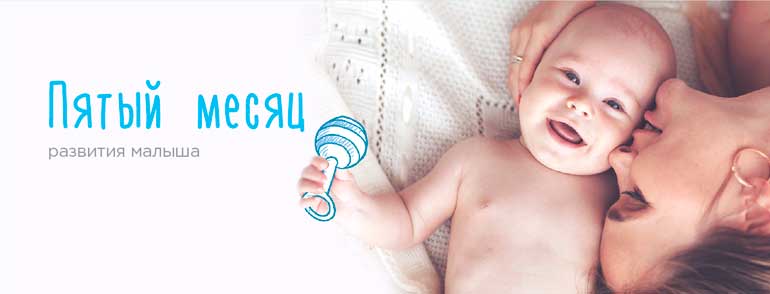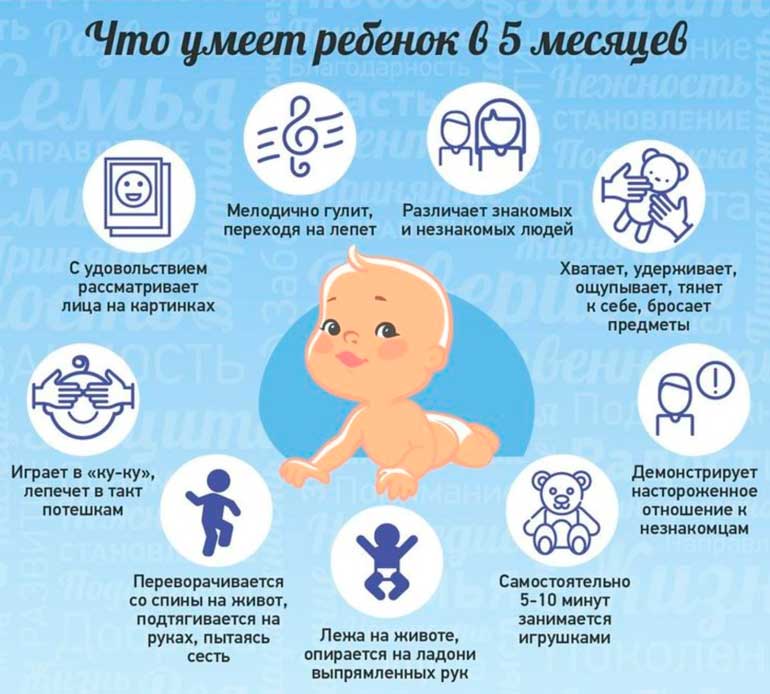At the 5th month, the child continues to master the communication tools: smile, laughter, babble, which become more expressive, lively every day, and are filled with meaning. He becomes more active and mobile in movement: he turns over, gradually from a lying position, gradually strives for a sitting position, independently takes various poses. The development of a child at 5 months is a period of consolidation and improvement of previously acquired skills and a transition to a new lifestyle, when the baby can already sit.

Physical development
Height and weight
Multiply by two the body weight of your baby at birth - about five months a baby now weighs about as much. At the end of 5 months, the baby should have a weight of 6.5 - 7.5 kg (± 1 kg) and a height of 63 - 65 cm (± 3 cm). For this month, he gains up to 700 g and adds about 2 cm.
Almost all unconditioned reflexes in a child by 4 to 5 months fade (see 4 month), Moro's reflex should disappear by the end of the 5th month. (About reflexes)
In the physical development of the baby, noticeable changes are observed.
What can a child do at the end of the 5th month
- A child of 5 months can already sit well with support from the back, holding on to something with his hands. He cannot sit on his own yet (when does the child begin to sit on his own?).
- If you put the child in an upright position, supporting behind the armpits, then he stands almost straight, without bending the legs.
- If you hold the baby in the air parallel to the floor, face down, then he lifts the upper body and head to the midline and holds them in this position.
- If you pull it by the handles in a supine position, the baby will pull himself up and prevent the head from tipping back.
- Lying on the back, the child raises his legs and arms, examines them, pulls his feet into his mouth.
- Lying on his stomach, he rises on his forearms and confidently holds his head.
- He reaches out to a moving object and can grab it already.
- Actively flips to the side, from the abdomen to the back.
- The spinal muscles of a child at 5 months old are already developed enough for him to be able to make an “airplane”: lying on his tummy with a raised head, moves his arms and legs.

We read in detail: what a child can do at 5 months
Psychological development
- The baby’s babble becomes more legible, these are not primitive separate sounds, but their combination: “ma”, “nya”, “yes”, “ba”. The child says them, repeating several times in a different combination, giving out something like a pipe.
- The baby at times “talks” to itself, clearly separating the syllables.
- Distinguishes strict and gentle intonation. It may be offended when they curse or shout at him. Silent when talking to him, listening carefully.Tries to attract attention.
- The child easily recognizes familiar faces, guarded at the sight of new people. Reacts to facial expression. It captures the connection between hair, eyes, voice, remembers the image as a whole. He likes to consider images of faces in pictures, prefers smiling.
- Even if the baby seems sociable in the presence of his mother, then without her, next to strangers, he becomes fearful.
- In the fifth month, the ability to visually control the movements of the hands improves: the baby can easily pick up the desired object by looking at it.
- While he cannot find a toy covered with something, but if it is not completely closed, the child will understand where it is hidden.
- Some children may already remember the quality characteristics of objects, for example: the color or size of the toy, what it feels like, and prefer these things to others.
- By the beginning of the 6th month, the baby can not only grab and hold the toy, but pull it towards itself, take it away.
- The child can now devote 5-10 minutes to independent play.
If some skills (see 4 months.) the child does not have, it is necessary to consult a pediatrician.
How to help your child grow
In this period, classes with the child must certainly focus on the development of the musculoskeletal system. Particular attention should be paid to exercises for the muscles of the back, since the baby needs to learn how to sit, as well as consolidating the skill of a coup from the back to the tummy and vice versa. It is necessary to conduct daily 20-30 minutes gymnastics in combination with massage. It is recommended that all exercises be accompanied by a count, so the child develops a sense of rhythm. You can turn on rhythmic music.
Squat exercise with deflection of the spine (do 1 time per day):
- The child lies on the back. Put the thumbs of your hands in the baby’s hands, let him squeeze them. With the remaining fingers, grasp the child by the wrists;
- Spread the child’s hands slightly to the sides and pull him towards you until the baby sits down;
- Then raise the baby's hands up and fix them there with one hand;
- Using your fingers of your free hand, move the crumbs from the bottom up along the spine. The child at the same time reflexively straightens the back;
- After that, gently supporting the head, put the baby in its original position.
"Creep": lying on their tummy, the kids are already striving to reach the toy lying next to it. This is not yet called a crawl, but can be considered the first step towards crawling. Lay toys next to the baby in a distance slightly larger than the outstretched hand of the child. With your palm, create support for his legs. Let the baby try to crawl and grab items. This will be good gymnastics for all muscle groups of the baby.
Massage for a child at 5 months should be somewhat more complicated. In addition to rubbing, stroking, vibration and striking, you can use tingling, tongs-like kneading and felting.
Keep carrying the baby in your arms. "Talk" with him, tell and show him everything around him. Allow the baby to examine as many objects as possible, but be careful, because the child now pulls everything in his mouth, so watch for the cleanliness of the toys and the safety of the surrounding objects.
For a while, the baby can now be placed in the playpen, but do not leave it there for a long time. A long stay in an arena or crib gives the crumbs the impression of isolation and limited space and can dull the child’s desire to explore the world.
Games
For a five-month-old baby, the games “Ku-ku”, “Magpie-crow”, “There is a horned goat”, “Ladushki” will be interesting. (see 4 months). At this age, kids love games with different sounds:
- “As animals say”: utter sounds imitating animals. At the same time, call the beast and show it in the picture;
- Read books with nursery rhymes and quatrains to the child; they develop the memory of the baby;
- Touch different parts of the child’s body, affectionately calling them: snub-snub, blue eyes, pink cheeks;
- Sew small bells to the baby's socks, let them ring when the child moves his legs. On the handles you can make bracelets with bells or bright stripes (butterfly, flower), the baby will look at them when he picks up the handles;
- Roll call: gradually introduce new syllables into the baby’s vocabulary. Listen carefully to what the child is “saying”, and then answer him as if you are holding a conversation. After some time, the baby will repeat after you. It is important that the baby see your face, observe gestures and facial expressions.
Play with the baby in front of the mirror. Take the baby in your arms and wave your hand to the reflection in the mirror. Perhaps the baby will be very surprised at the appearance of a second mother with someone in her arms. While the child perceives the reflection in the mirror as another living object. If you take a toy in your hand, the baby will try to grab it in the mirror without noticing it in your hands. Until about 1.5 years old, children do not understand that the mirror is only a reflection.
To develop tactile sensitivity, make a set of multi-colored pads from different fabrics (flannel, silk, velveteen). When the baby lies on his tummy, give them to him, let him touch and stare. When the child grows up, such pillows can be laid out in pairs by color, size or pattern.
If you like to sew, you can make a textile book especially for your baby with appliqués from different fabrics, Velcro, lacing, sewn buttons. The subject of the book may be different, depending on the gender of the child.
Food and sleep
The regimen of sleep and wakefulness in a child at 5 months remains the same as in the last month (see 4 months). For each baby, it is individual and depends on biorhythms and temperament: someone wakes up early and goes to bed the same way, while someone likes to get up later and “walk” at midnight. Kids can still be confused day by night, but many children already sleep longer at night than during the day, waking up 1-2 times.
Feeding remains unchanged (see 4 months.). Continue breastfeeding or formula as required.
At 5 months, the introduction of the first feeding is allowed if:
- You have little milk;
- The child does not gain weight well, is naughty, does not overeat;
- He is tormented by stomach pains or constipation, sparse or scanty stools;
- He often spits up (more than 2 times per day or after each feeding).
In any of these cases, consult a pediatrician to determine that the cause is indeed malnutrition and to select the first complementary foods.
We read: About the first feeding and important article about5 month's day routine
Video: 5 month baby development
Mom’s School: Fifth month of life. Child Development Calendar
A full calendar of the development of the child in one article “development up to a year by months” -https://kid.htgetrid.com/en/razvitie-rebenka-do-goda/razvitie-rebenka-do-goda-po-mesyatsam.html









Thank! Informatively very helpful.